Charles William Johnson
IntroductionIn the complement of the Pythagorean Theorem, we observed the series of right triangles based on (Cfr., Earth/matriX, Science Today, Extract 3):
(42 + 1) + 82 = 92
(62 + 1) + 182 = 192
(82 + 1) + 322 = 332
(102 + 1) + 502 = 512
(122 + 1) + 722 = 732
(142 + 1) + 982 = 992
Now, let us move beyond the treatment of squares (n2) and proceed to an understanding of the Pythagorean Theorem as of the cube (n3). Exponents to the power of three are not considered generally in the treatment of the Pythagorean Theorem. In previous analyses, we examined a progression of perfect right triangles that could be expressed by the extension of the Pythagorean Theorem (Cfr., Earth/matriX: Essay No.58):
x3 + y3 + z3 + = w3
33 + 43 + 53 = 63
63 + 83 + 103 = 123
123 + 163 + 203 = 243
...
Now, we shall examine a series of right triangles, which are perfect right triangles in our mind, that reflect whole numbers in their computations, and may be ascertained by way of the power of three. The procedure involved is suggestive of the complement of the Pythagorean Theorem and in fact reflects similar numbers.
An Alternative Proof of the Pythagorean Theorem by Exponent n3The series of perfect triangles refers to the following numbers:
(63 + 1) + 83 = 93
(123 + 23) + 163 = 183
(183 + 33) + 243 = 273
(243 + 43) + 323 = 363
(303 + 53) + 403 = 453
The striking feature of this series concerns the progressive numbers of the second term within the parentheses. Because of this particular progression, we may consider listing the series with the second term placed first in the equation.
23 + 123 + 163 = 183
33 + 183 + 243 = 273
43 + 243 + 323 = 363
53 + 303 + 403 = 453
...
Regarding the 1 • 6 • 8 • 9 expression, the reader may wish to examine our previous study, as it shall be helpful in reviewing the analysis herein. {Cfr., Earth/matriX, Science in Ancient Artwork Essay 6, The Maya-Kemi Baseline). Many of the equations in this series reflect the historically significant numbers of the ancient reckoning system. This means that, once again, the numbers cited in the historical record are to be found within the realm of mathematics and geometry in a most natural manner. Consider some of the equational expressions that we shall be discussing below:
133 + 783 + 1043 = 1173
213 + 1263 + 1683 = 1893
263 + 1563 + 2083 = 2343
363 + 2163 + 2883 = 3243
523 + 3123 + 4163 = 4683
543 + 3243 + 4323 = 4863
633 + 3783 + 5043 = 5673
653 + 3903 + 5203 = 5853
2083 + 12483 + 16643 = 18723
7563 + 45363 + 60483 = 68043
14603 + 87603 + 116803 = 131403
...
Many historically significant numbers appear on this series.
Today, when we think about a triangle (be it perfect or not), we generally think a form with three sides (or three angles). The natural divisions are made and conceptualized at the meeting point of each of the three angles. We generally do not relate these three sides or angles to anything other than three sets of numbers, as in the Pythagorean Theorem. The case may be that this particular series served the ancients in their computations and symbolic representation of the historically significant numbers in their artwork. For, these sets of four numbers taken to the fourth power, allow for proving the Pythagorean Theorem of a right triangle.
The four numbers may be employed as the length measurements of the sides of a triangle divided in the following manner, reflecting essentially the 3 • 4 • 5 perfect right triangle numbers:
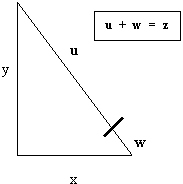 |
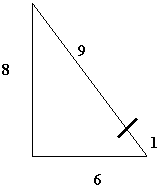 |
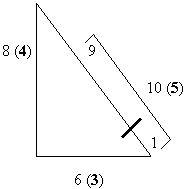 |
Some specific examples of distinct measurements, multiples of the 3 • 4 • 5 triangle:
 |
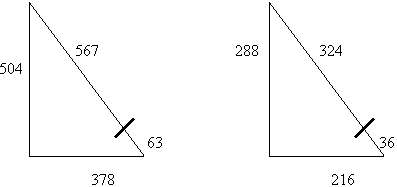 |
These triangles may be generated as of these measurements and proven through the cube (n3) of these same measurements, reflecting a relation of equivalency.
| 633 + 3783 + 5043 = 5673 | 363 + 2163 + 2883 = 3243 |
Likewise, the Pythagorean Theorem may reflect a proof of the same relationship to the power of two (n2). All one must do is add up the respective integers of the hypotenuse of the triangle.
| 3783 + 5043 = 567 + 63 | 2163 + 2883 = 324 + 36 |
and, change the cube into exponents of two (n2):
| 3782 + 5042 = 6302 | 2162 + 2882 = 3602 |
With that, the perfect right triangles are expressed in whole terms either to the cube or to the square. The internal division of the lines is something that we are not accustomed to in contemporary mathematics and geometry. However, the case may be that the ancients employed this kind of partial divisions in order to be able to symbolically represent the historically significant numbers of their reckoning systems in the artwork.
The most striking example of this possible practice may be found in the profile design of the Great Pyramid (as well as in many other ancient works). Let us illustrate the numbers on the Great Pyramid, remembering that the entrance to the pyramid dissects the hypotenuse in a similar fashion as discussed above.

These are not the exact measurements of the Great Pyramid as we know it today. In fact, another essay is required to discuss this particular equation with respect to those measurements. But, one thing is certain; this particular triangle as of these measurements, produces an angle of inclination of around 53o, which should be examined in greater detail later. One could imagine adjustments being made regarding the height (to the 481.5 feet considered today) and the lesser angle of inclination (51o 50' 00"0; more or less). (Cfr., Earth/matriX, Essay 77, regarding the significance of the number 63.)
 |
 |
Notice how the numbers behave, in that the first and last terms of the two distinct equations share common fractal numbers.
|
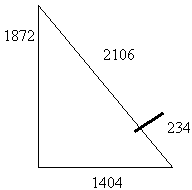 |
Again, in the previous example, four historically significant numbers/fractals make their appearance in a single triangle. Even the hypotenuse 2340 (= 2106 + 234) reflects a fractal thereof.

Another example reflects the Consecration (432) and the Platonic Cycle (25920) fractal in relation to another historically significant number (3888); not to mention the 3456 number of the extension of the Pythagorean Theorem. To observe so many historically significant numbers on a single example of the natural occurrence of numbers in a geometrical expression somehow defies the concept of coincidence. We continue to consider the possibility that the apparently random historically significant numbers/fractals are based in nature and its scientific study. And, the additional fact that these sets of numbers produce a triangle whose base angle is 53o, which is quite similar to that of the Great Pyramid, furthers such a consideration as to deny coincidence.
The Constant .665641024Now, in order for the series to make sense in geometrical terms, we must graph the numbers and observe how they behave. In doing so, we shall see that there exists a mathematical procedure and a geometrical procedure; each distinct in its own right. Something similar occurs with the Pythagorean Theorem itself. For, at the level of the terms of the Pythagorean Theorem, a triangle may be graphed whose measurements of its sides coincide with the numbers of the terms (for example, as in a 3 • 4 • 5 triangle). However, at the level of the products of the squares of those terms/numbers, a relation of equivalency is obtained that confirms the possibility of the triangle. Therefore, the 3 • 4 • 5 numbers reflect the geometrical nature of the Pythagorean Theorem, while the relation of equivalency (for example, 9 + 16 = 25) reflects the mathematical aspect of the Pythagorean Theorem.
Such a distinction between mathematics and geometry also occurs within the extension and alternative to the Pythagorean Theorem.
Let us graph a few examples in order to illustrate this particular point and show how the math and the geometry interconnect at the level of the exponent n3.
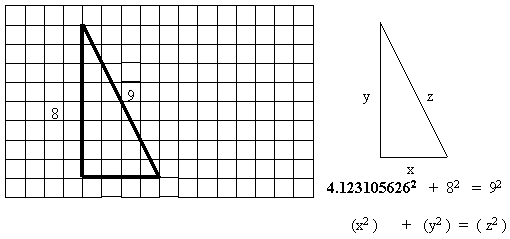
From the previous illustration, we may observe that if we draw a line (y) of 8 units, and a line (z) of 9 units, then the line (x) does not reflect a six, but rather a measurement close to 4 units on the graph paper. If we were graphing squares of numbers, as in the Pythagorean Theorem, then we should certainly find the triangle to reflect the measurements of 4.1231056262 + 82 = 92 , which would reflect the above illustration on the graph. However, because we are graphing the cube of sides 8 and 9, then the measurement of the base is quite off a four units plus.
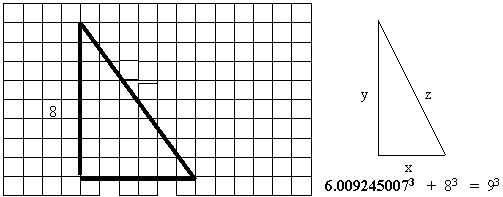 |
An extremely interesting constant number makes its appearance with this particular relationship between these two series of triangles, one base on the exponent n2 and the other based on the exponent n3. In order to translate from one baseline to the other of these two series, the constant number .665641024 makes its appearance. If we take the whole integer of the baseline 4.123105626 and divide that by the baseline of the triangle to the cube, we obtain the following:
| 4 / 6.009245007 | = | .665641024 | 6.0092450073 + 83 | = | 93 | |
| 8 / 12.01849001 | = | .665641024 | 12.018490013 + 163 | = | 183 | |
| 12 / 18.02773502 | = | .665641024 | 18.027735023 + 243 | = | 273 | |
| 16 / 24.03698003 | = | .665641024 | 24.036980033 + 323 | = | 363 | |
| 20 / 30.04622503 | = | .665641024 | 30.046225033 + 403 | = | 453 | |
| 24 / 36.05547004 | = | .665641024 | 36.055470043 + 483 | = | 543 | |
| 28 / 42.06471505 | = | .665641024 | 42.064715053 + 563 | = | 633 | |
| ... |
This constant number would then serve to translate from one triangle to another on either series. One cannot help but recognize the similarity with the maya companion number 1366560. In previous studies, we have toyed with the idea that the maya companion number may represent (13)(6656), a breakdown in the manner in which numbers are conceived in the ancient reckoning system.
How terribly coincidental it is to find a constant number existing between two series of triangles and a number that resembles one of the ancient reckoning numbers. Had the ancients wished to produce a relational equivalency between a particular number set on either series, they could have employed the constant .6656 and the whole number integer in order to achieve an approximate relationship. Another significant point is to recognize that 13 divided by 6656 or 6656 divided by 13 yield the constant series 1, 2, 4, 8, 16, 32, 64, 128, ... while 13 x 6656 yields the historically significant series of the square of 52c (2704):
A good case can be made to demonstrate the possibility that the ancients viewed the compound numbers in such an encoded manner. As we have seen throughout the Earth/matriX series of essays and extracts, historically significant numbers appear within a specific number. For example, the historically significant number 108864, to cite an isolated case, represents a compound number of the historically significant numbers 108 and 864. To consider the possibility that the maya companion number 1366560 may represent other historically significant numbers in a compound fashion may represent a similar case.
It seems highly suspect to find a naturally existing constant number (.6656) serving as a translation factor between the baseline of a right triangle whose manifestation comes by way of the exponent n2 in relation to the baseline of a triangle whose exponent is n3. And, then we find just such a number within the historical record in an ancient reckoning system that relied obviously upon mathematics and geometry for its computations.
Now, if the ancients viewed compound numbers as computationally relevant, as we have seen them to be throughout our many analyses, then one would not be surprised to view a breakdown of a triangle in a distinct manner than that which we are accustomed to consider. For example, as we have seen in our study, the triangle which breaks down the line z, the hypotenuse, allows for the confirmation of its terms in whole numbers to the power of three.

Who is to say that the ancients did not view the previous perfect right triangle from two vantage points; that of exponent n2 and exponent n3. From either procedure the nature of the triangle may be discerned.
| w3 + x3 + y3 | = | u3 | x2 + y2 | = | z2 | |
| 13 + 63 + 83 | = | 93 | 32+ 42 | = | 52 | |
| 1 + 216 + 512 | = | 729 | 9 + 16 | = | 25 | |
| 729 | = | 729 | 25 | = | 25 |
From the perspectives of mathematics or geometry, it matters not which procedure is followed, the end result is the same: a relation of equivalency is achieved in both thereby confirming the nature of the triangle being a perfect right triangle.
It would appear that our contemporary procedure, based on the Pythagorean Theorem, came to us from the use of the exponent of n2. While, possibly, the ancients may have preferred to work with four terms as of the exponent n3. This allowed for them to account for more relationships regarding the historically significant numbers, which could be more easily represented in a symbolic manner in their artwork based on this particular division of the sides of a triangle. As we have observed, the Great Pyramid appears to have followed such a design.
Contemporary society, then, seems to enjoy the simpler formula of three terms to the square, while the ancients may have enjoyed a more complex formula of four terms to the cube. The use of either could simply be a matter of preference or, as may have been regarding the ancient reckoning system, a matter of conveying the historically significant numbers in a more illustrative manner.
ObservationThe series of perfect right triangles studied herein may be measured and confirmed as of the exponent two (n2) or, three (n3), as of the corresponding terms of the equation. The internal division of the triangles based on a relation of equivalency to the cube sets the basis for confirmation of the equivalency of the relationship to the square.
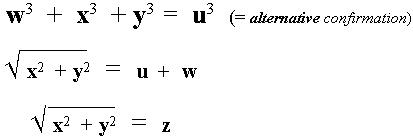
Beyond the Pythagorean Theorem entails, then, various levels of analysis regarding possible relations of equivalency for right triangles and perfect right triangles.
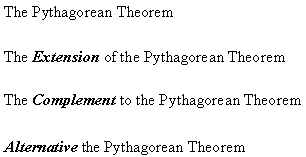 |
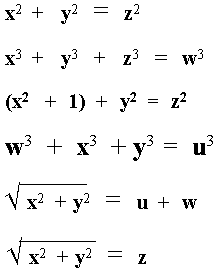 |
All of these equations perform with whole numbers. The ancients sought to avoid the fractions. Today, we appear to be obsessed in a way with fractions and their apparent preciseness. The ancient no doubt understood the fractions, precisely because they sought to avoid them. Consider a simple computation in relation to the ancient maya figure often cited for the recession: 25956. Let us take the double of the calendar round (18980 and the 360c day-count):
| 37.962 + 7202 | = | 720.99997342 | ||
| 720.9999734 x 360c | = | 259559.9904 ( = 25956) |
One can only suspect that the ancients comprehended the powers of the natural numbers. Possibly, today we do not see the whole numbers, because of our concentration on the apparently precise fractions computed to an infinite number of decimal places [as in contemporary renderings of the concept of pi (p) to thousands of decimal places].
All right triangles of the 1-6-8-9 variation, as illustrated in our analyses regarding an alternative approach to the Pythagorean Theorem, may be expressed in whole numbers, and in that would be considered to be "perfect" right triangles in contemporary usage.
*****
More links
©1999-2013 Copyrighted by Charles William Johnson. All Rights Reserved. Reproduction Prohibited. Earth/matriX. SCIENCE IN ANCIENT ARTWORK. SCIENCE TODAY SERIES. johnson @earthmatrix.com
| Home | Books | All Essays | Author |